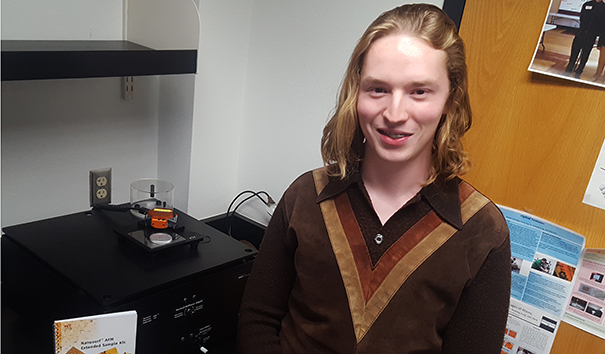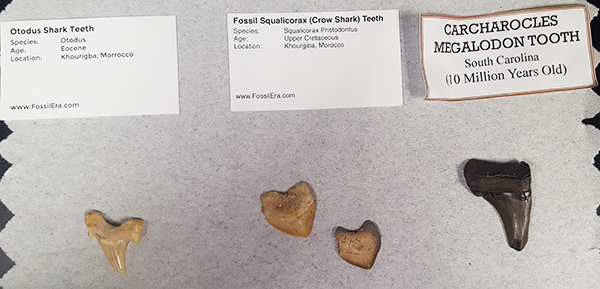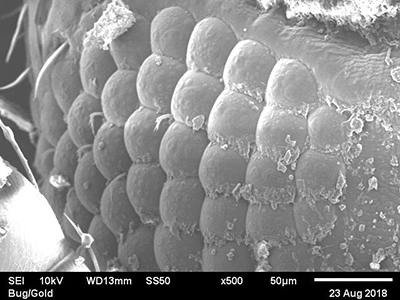Hello, my name is Josh Parsons, and I’m a student employee on the University of Northern
Colorado’s University Relations team. In this podcast, Creative Content Producer,
Katie Corder, sits down with UNC student Jacob Fry. Jacob is a senior physics major
from Aurora.
Jacob received over $1,000 in funding from the Office of Undergraduate Research to
compare the chemical make-up of shark teeth using two nanotechnologies. Nanotechnology
is basically science, engineering and technology conducted at the nanoscale, equal
to one billionth of a meter. It allows researchers to see a vivid image of an item
at the atomic and molecular scale.
The first technology he used was an Atomic Force Microscopy, or AFM; this measures
an item’s height, friction and other characteristics. The second one was a Scanning
Electron Microscopy, or SEM; this creates images of surface characteristics, such
as topography and composition.
From this, he created lab curriculum that will be used during the spring of 2019 as
a how-to guide for these nanotechnologies.
Can you describe your research to me?
Originally, when it started, I just wanted to look at these shark teeth using something
that wasn’t just my eye. I wanted to see what I could learn from this new form of
microscope and see what else is down there … what is in this bone? But it’s basically
just looking at the chemical response of these electrons and different chemicals that
are trace elements in these fossils and seeing first of all where their environment
was when they died, what they were eating, and from there, hopefully draw some conclusions.
My research deals with looking at the teeth of dead sharks to determine where these
sharks were when they were living. And from there, I wanted to learn more about nanoscience
because it’s really neglected, it’s pivotal in everything we do. If you’re doing almost
any research now, you’re going to need a nano instrument, so I wanted to learn how
to use them, so I could teach others to use them.
What kind of chemicals would be found on these teeth?
It depends on the ocean, so this is a little Squalicorax — they call it the, “crow
shark.” They do that because they’re basically slicing into flesh, so you’re going
to get silicone dioxide, which what does that mean to anyone not in science? It didn’t
mean anything to me honestly, I had to Google it. That’s in everything; it’s in living
tissues, so as something that seared and ripped flesh, it’s still sharp. It’s going
to have that trace amount, not only because it’s a fossil, and it’s in that living
organism, but because it’s tearing flesh from organisms. So, when this fell down to
the sea floor, it had that chemical component with it. But that was very minute, this
was coated in gold, so the electrons would react, and I’ll probably made it a necklace,
so it had traces of gold. It also of course had calcium — bones are made of that —
and salt, which you’d would expect in the ocean.
Your research is basically … you’re using two different imaging capabilities and limitations
between the AFM, which stands for Atomic Force Microscopy, and SEM, scanning electron
microscopy.
It sounds like you started off with the AFM, so I assume that’s more of the norm,
and then you decided to test that with a different imaging tool, the SEM, so can you
go into summary about those two?
The AFM … it’s basically Braille. You know how blind people will use the bumps on
something, and they’ll know the meaning of the text? What this thing is using is the
braille of microscopy. It’s feeling for the indentations and bumps on a surface and
basically electrons repulse each other; they do not want to be close to each other,
and so, that force that’s causing a little leaver to bounce back and forth, it is
being read by a laser, and that is what’s constructing the image. So, from there,
you can see basically the topography, so a 3D map. That proved really hard actually
for the teeth because a nanometer to the AFM is a canyon to us. And teeth are notoriously
curved, and so the AFM images weren’t actually that stupendous. I was having to break
the teeth and sand them; I actually went to Home Depot to get proper tools, and even
then, you really could only see a basic pattern in all the teeth, so no matter what
species I looked at, the same pattern, it was almost like waves would appear on the
teeth. So, my research advisor, Dr. Sung, said you should use this instrument and
this instrument, and she suggested like probably four other ones, and I was like,
“Okay, the SEM, I can do that.” So, I went to that one.
And what is SEM?
The SEM is a monster, let me tell you. The SEM … it’s just like a normal microscope
in the sense it’s using light, and it’s focusing a beam of electrons onto the sample,
and that’s why that tooth over there was coated in gold because you want these electrons
to conduct. And bone … it’s not conducive for conducting, so basically, I focus the
beam, and depending on how the beam bounces back, I can determine what elements are
in there because every element’s different; they’re all individuals to a certain extent.
That’s basically what the SEM does. It has a few other functionalities like the EDS,
which is just an element analysis that’s how I determine what composition this tooth
is. And I think that’s the gist of it.
You said that also it’s way more vivid in detail?
Oh, yes. Going from AFM and then looking at an SEM picture, it’s more intuitive for
the human eye because with the AFM it’s sort of like going to the moon and trying
to determine all these geographical landmarks and then going out to your backyard
with the SEM, and you know every single thing.
So, it gives you a more descriptive picture of what you’re looking at verses a vague,
broad picture; therefore, by doing that, you were able to analyze the shark teeth?
Yeah, the AFM does have some potential on really flat things like I have a picture
behind me of a CD stamper, and that’s weird, you would never expect a CD to look like
that, but it does. It looks almost like an alligator’s skin.
Can you explain nanoscience?
It’s just science that’s really small … not quite quantum but nano. The issue that
nanoscience faces is it’s really expensive. I had a scare a few weeks ago where I
thought I had broken the cantilever tip on my AFM machine, which is a very expensive
fix. Luckily, I was just being stupid, but there is that financial limitation to the
research, and that’s why part of my goal was to develop a plan that exposes undergraduates
to nanoscience early without breaking the entire department.
So how are you going about doing that on the more academic curriculum side?
Well, the labs actually kind of wrote themselves because I am a student, and I can
think how they’re thinking because I am in a lab physics course right now. I think
the biggest challenge of all was getting it condensed into a lab session, maybe two.
That was very difficult because, especially with the AFM, you can spend an entire
session just figuring out how to turn it on and get imaging. That was not necessarily
a challenge for the SEM because there are enough tutorials, and it’s pretty intuitive
because it’s visual; whereas, it’s using quantum mechanics, which any quantum physicist
will tell you they don’t understand it, so that was the big challenge.
Basically, you’re bringing this more for undergrad researchers interested in nanoscience.
How long have you been doing that, and how many classes have you helped shape?
Probably only one directly, which will be next semester’s lab course, which I’m actually
taking and that’ll be interesting because it’s like I’m testing my own hypothesis,
but I think indirectly it will shape a lot of future courses because it may unlock
the potential of these instruments.
Because right now, there are a lot of labs we’re doing in this semester’s course that
have been done for over a century. They’re good experiments, they teach you how to
think criticality, but if you want to go to industry as a physicist, chemist, biologist,
anything that is based on the innovations of today, you can’t be playing with a lightbulb,
and you won’t gain the technological advantage from doing that.
That’s really fun to see how it turns out because that could influence the future
of research and classroom here at UNC.
I’m scared because to me these labs are like I can go through them in 30 minutes,
and so I didn’t want them to first be too long, so we’ll see if I made horrible labs
that’ll take weeks!
Go back to that Office of Undergrad Research grant: Can you describe the funding you
received, and how you went about getting it, like the steps involved?
It was really easy. So, I just sent a little essay, all this preliminary information,
and I didn’t expect to get the full amount I requested, but not enough people applied;
there were very few people who applied for research grants, so I lucked out and relatively
quickly I got the funding. And so, I wasn’t planning on even being able to buy samples
until mid-July, and it might have been early June, maybe even May, of last year, I
got the funding, and it was sort of like a teenager who gets their first paycheck,
I just kind of splurged. I got all the best-looking teeth from the Mid-Cretaceous.
How much funding did you receive?
So, about a grand, a little over that.
And that covers everything you need?
It did, and I was worried that I wouldn’t receive enough to cover a Megalodon tooth
because they were the biggest shark that ever existed, you can charge an extra penny
for them.
So, what got you into physics? Just because it was a challenge?
I wanted physic because it was hard. I struggle with it every day. You’re going to
college to get something you couldn’t otherwise get, and I could not teach myself
physics if I tried. I needed to be pushed, I needed days where I was close to tears.
I think that was a good way to spend my money.
Can you describe the end goals of this research that was funded as well as any potential
next steps?
My end goal is that students enjoy doing nanoscience. They can see the potential in
it. Because nanoscience isn’t just a series of instruments that measure quantity.
They’re not just scales where you put sample on and write down your notes. I think
that was the big thing I learned from this, and where future research can jump off
from is there is more to look at with even just shark teeth because I did not hit
the full potential of the AFM there are other ways of using this machine. You could
get an AFM that operates in water, in a vacuum setting, and that might give you entirely
different results. You can adjust parameters in this machine and make it almost like
an art project.
Can you describe how UNC and the faculty here have assisted you through this research
and this funding?
I think I am in a unique position on this campus where my department, physics, they
really care about undergrads, which is rare because in most institutions grad students
teach the undergrads, but we don’t have a grad program, and the faculty fight to keep
this undergraduate-only so they can focus on us. And, I think they just go out of
their way to make sure everyone is understanding things, but they don’t coddle us.
At the same time though, they are supportive with my research, they’re always saying,
especially Dr. Sung, she’s always giving me articles to read, providing me with new
information, making events and opportunities possible. I think they’re extremely supportive.
Would you say UNC is a unique institution for supporting undergrad research outside
of the, what would be considered, norm in undergrad research at other places?
I think my department and probably loads others are amazing. I think this is one of
the few universities that puts education first and puts the money side of things in
the back of their mind, which is very rare and commendable.
Thank you, Jacob, for your time and doing the research and everything.
Thank you, of course.
Good luck to you.


 After using the AFM and SEM, Fry said the the AFM provides a great image of samples
with flat surfaces, but the SEM provides more detail and information about the sample. (Image at right: a close-up of a bug eye viewed under the SEM).
After using the AFM and SEM, Fry said the the AFM provides a great image of samples
with flat surfaces, but the SEM provides more detail and information about the sample. (Image at right: a close-up of a bug eye viewed under the SEM).




